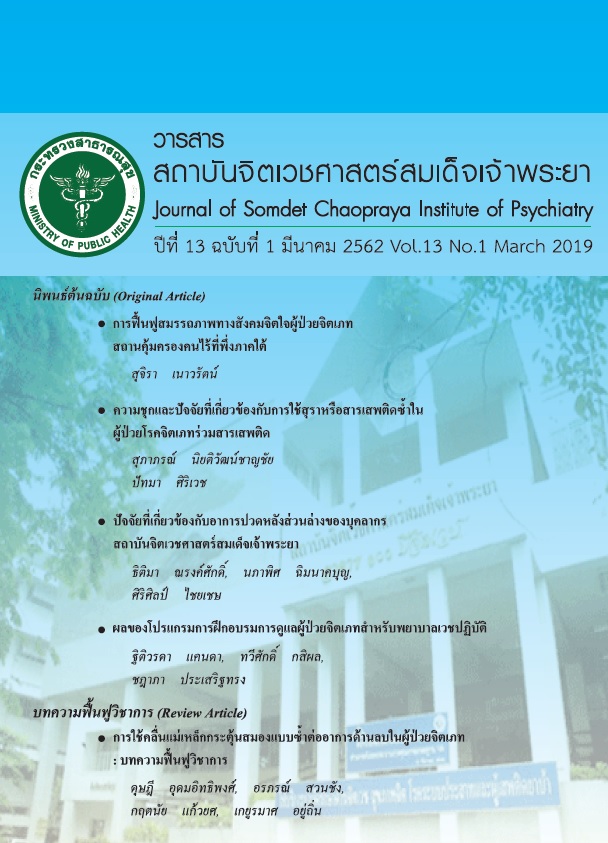การใช้คลื่นแม่เหล็กกระตุ้นสมองแบบซ้ำต่ออาการด้านลบในผู้ป่วยจิตเภท: บทความฟื้นฟูวิชาการ
คำสำคัญ:
คลื่นแม่เหล็กกระตุ้นสมองแบบซ้ำ, โรคจิตเภท, อาการด้านลบบทคัดย่อ
วัตถุประสงค์ : เพื่อทบทวนวรรณกรรมเกี่ยวกับการใช้คลื่นแม่เหล็กกระตุ้นสมองแบบซ้ำต่ออาการด้านลบในผู้ป่วยจิตเภท
วัสดุและวิธีการ : สืบค้นจากฐานข้อมูลอิเลคโทรนิกส์ต่าง ๆ ได้เเก่ ตำรา หนังสือ วารสาร และบทความวิชาการที่ถูกตีพิมพ์ ผ่าน PubMed, google, Web of Science ทั้งภาษาไทยและภาษาอังกฤษ โดยใช้คำสำคัญในการค้นหา ได้เเก่ คลื่นแม่เหล็กกระตุ้นสมองแบบซ้ำ อาการด้านลบ และผู้ป่วยจิตเภท
ผล : พบงานวิจัยที่ผ่านเกณฑ์ที่เกี่ยวข้องกับการใช้คลื่นแม่เหล็กกระตุ้นสมองแบบซ้ำต่ออาการด้านลบในผู้ป่วยจิตเภท 11 เรื่อง ได้แก่ งานวิจัยเชิงทดลอง 8 เรื่อง การวิเคราะห์อภิมานงานวิจัย 2 เรื่อง และทบทวนบทความ 1 เรื่อง จากงานวิจัยเหล่านี้ชี้ให้เห็นว่าการใช้คลื่นแม่เหล็กกระตุ้นสมองแบบซ้ำ เป็นทางเลือกหนึ่งของเครื่องมือที่ได้รับการยอมรับ ปลอดภัย และมีประสิทธิภาพของการบำบัดรักษา พบผลการศึกษาเปรียบเทียบด้วยการใช้การใช้คลื่นแม่เหล็กกระตุ้นสมองแบบซ้ำ ให้ได้ผลที่ดีกว่ากลุ่มควบคุมต่อการรักษาอาการด้านลบในผู้ป่วยจิตเภทนั้น ต้องใช้คลื่นแม่เหล็กกระตุ้นสมองแบบซ้ำที่ความถี่ 10 Hz เป็นเวลาอย่างน้อย 3 สัปดาห์ ติดต่อกัน กระตุ้นที่ตำแหน่ง dorsolateral prefrontal cortex และระยะเวลาของความเจ็บป่วยของผู้ป่วยจิตเภทต้องน้อยกว่าหรือเท่ากับ 8 ปี
สรุป : การใช้คลื่นแม่เหล็กกระตุ้นสมองแบบซ้ำ เป็นการรักษาอีกหนึ่งวิธีที่ปลอดภัย และมีประโยชน์ต่อการรักษาผู้ป่วยจิตเภทที่มีอาการด้านลบให้ดีขึ้นได้ จากการทบทวนวรรณกรรมครั้งนี้ มีข้อเสนอแนะในอนาคตควรมีการศึกษาในกลุ่มตัวอย่างที่มีขนาดใหญ่ และศึกษาปัจจัยอื่นที่เกี่ยวข้องเพิ่มเติมที่อาจส่งผลต่อการรักษา
เอกสารอ้างอิง
World Health Organization. Schizophrenia [online]. Available from: http://www. who.int/mental_health/management/ schizophrenia/en/ [2016 June 29].
Saha S, Chant D, Welham J, McGrath J. A systematic review of the prevalence of schizophrenia. PLoS Med 2005; 2: 413-33.
รัชตะ รัชตะนาวิน. ผู้ป่วยจิตเวชไทยพุ่งทะลุล้าน โรคจิตเภทสูงสุดกว่า 4 แสนราย วันสุขภาพจิตโลก 10 ตุลาคม 2557. [online]. Available from: http://www.manager.co.th/Home/ViewNews.aspx?NewsID=9570000117185 [2016 June 30].
มาโนช หล่อตระกูล, ปราโมทย ์ สุคนิชย์. จิตเวชศาสตร์รามาธิบดี. พิมพ์ครั้งที่ 8. กรุงเทพ: สวิชาญการพิมพ์, 2546.
Shamsi S, Lau A, Lencz T, Burdick KE, DeRosse P, Brenner R, et al. Cognitive and symptomatic predictors of functional disability in schizophrenia. Schizophr Res 2011; 126(1-3): 257-64.
Hansbauer M, Wobrock T, Kunze B, Langguth B, Landgrebe M, Eichhammer P, et al. Efficacy of high-frequency repetitive transcranial magnetic stimulation on PANSS factors in schizophrenia with predominant negative symptoms – results from an exploratory re-analysis. Psychiatry Res 2018; 263: 22-9.
Cernovsky Z. Quality of life in persons with schizophrenia. Ment Illn 2017; 9(1): 7052.
Buchanan RW, Kreyenbuhl J, Kelly DL, Noel JM, Boggs DL, Fischer BA, et al. The 2009 schizophrenia PORT psycho-pharmacological treatment recommendations and summary statements. Schizophrenia Bull 2010; 36: 71-93.
Erhart SM, Marder SR, Carpenter WT. Treatment of schizophrenia negative symptoms: future prospects. Schizophrenia Bull 2006; 32: 234-7.
Leucht S, Arbter D, Engel RR, Kissling W, Davis JM. How effective are second-generation antipsychotic drugs? A meta-analysis of placebocontrolled trials. Molecular Psychiatry. 2009; 14: 429-47.
Graziano B, Kaskie RE, Ferrarelli F. Transcranial magnetic stimulation (TMS) as a treatment tool in schizophrenia: A review. J Brain Neurol 2017; 1(1): 14-23.
Moller HJ. Management of the negative symptoms of schizophrenia: new treatment options. CNS Drugs 2003; 17: 793-823.
Wang RZ, Zhang JX, Yuan W, Tang JS, Liu JT, Li X, et al. A study of insist and psychopathology vignettes in patients with schizophrenia. Shandong Jing Shen Yi Xue 2001; 14(4): 237-40.
ภารดี เอื้อวิชญาแพทย์, ธวัชชัย กฤษณะประกรกิจ. การกระตุ้นแม่เหล็กไฟฟ้าผ่านกะโหลก. ศรีนครินทร์เวชสาร 2552; 24(3): 148-53.
Machii K, Cohen D, Ramos-Estebanez C, Pascual-Leone A. Safety of rTMS to non-motor cortical areas in healthy participants and patients. Clin Neurophysiol 2006; 117: 455-71.
Khurshid K, Janicak P. Other than depression: using transcranial magnetic stimulation. Psychiatr Ann 2005; 35(2): 147-58.
Becker JE, Maley C, Shultz E, Taylor WD. Update on transcranial magnetic stimulation for depression and other neuropsychiatric illnesses. Psychiatr Ann 2016 ; 46(11): 637-41.
Slotema CW, Blom JD, Hoek HW, Sommer IE. Should we expand the toolbox of psychiatric treatment methods to include repetitive transcranial magnetic stimulation (rTMS)? A meta-analysis of the efficacy of rTMS in psychiatric disorders. J Clin Psychiatry 2010; 71: 873-84.
Fitzgerald PB, Herring S, Hoy K, McQueen S, Segrave R, Kulkarni J, et al. A study of the effectiveness of bilateral transcranial magnetic stimulation in the treatment of the negative symptoms of schizophrenia. Brain Stimul 2008; 1(1): 27-32.
Sayar GH, Bulut H, Tarhan N. Use of repetitive transcranial magnetic stimulation in treatment of negative symptoms of schizophrenia. J Neurol Sci Disord 2015; 1(1): 017-021.
Cohen E, Bernardo M, Masana J, Arrufat FJ, Navarro V. Repetitive transcranial magnetic stimulation in the treatment of chronic negative schizophrenia: a pilot study. J Neurol Neuro Surg Psychiatry 1999; 67: 129-30.
Rollnik JD, Huber TJ, Mogk H, Siggelkow S, Kropp S, Dengler R , et al. High frequency repetitive transcranial magnetic stimulation (rTMS) of the dorsolateral prefrontal cortex in schizophrenic patients. Neuroreport 2000; 18(11): 4013-5.
Hajak G, Marienhagen J, Langguth B, Werner S, Binder H, Eichhammer P. High-frequency repetitive transcranial magnetic stimulation in schizophrenia: a combined treatment and neuroimaging study. Psychol Med 2004; 34(7): 1157-63.
Dlabac-de Lange JJ, Knegtering R, Aleman A. Repetitive transcranial magnetic stimulation for negative symptoms of schizophrenia: review and meta-analysis. J Clin Psychiatry 2010; 71: 411-8.
Zhao S, Kong J, Li S, Tong Z, Chanjuan Y, Huaqing Z. Randomized controlled trial of four protocols of repetitive transcranial magnetic stimulation for treating the negative symptoms of schizophrenia. Shanghai Arch Psychiatry 2014; 26: 15-21.
Zheng LN, Guo Q, LI H, LI CB, Wang JJ. Effects of repetitive transcranial magnetic stimulation with different paradigms on the cognitive function and psychotic symptoms of schizophrenia patients. Beijing Da Xue Xue Bao 2012; 44(5): 732-6.
Wobrock T, Guse B, Cordes J, Wolwer W, Winterer G, Landgrebe M, et al. Left prefrontal high frequency repetitive transcranial magnetic stimulation for the treatment of schizophrenia with predominant negative symptoms: a sham-controlled, randomized multicenter trial. Biol Psychiatry 2015; 77: 979-88.
Prikryl R, Ustohal L, Prikrylova Kucerova H, Kasparek T, Venclikova S, Ceskova E. A detailed analysis of the effect of repetitive transcranial magnetic stimulation on negative symptoms of schizophrenia: a double-blind trial. Schizophr Research 2013; 149: 167-73.
Prikryl R, Kasparek T, Skotakova S, Ustohal L, Kucerova H, Ceskova E. Treatment of negative symptoms of schizophrenia using repetitive transcranial magnetic stimulation in a doubleblind, randomized controlled study. Schizophr Res 2007; 95(1-3): 151-57.
Levkovitz Y, Rabany L, Harel EV, Zangen A. Deep transcranial magnetic stimulation add-on for treatment of negative symptoms and cognitive deficits of schizophrenia: a feasibility study. Int J Neuropsychopharmacol 2011; 14(7): 991-6.
Shi C, Yu X, Cheunge E, Shum D, Chana R. Revisiting the therapeutic effect of rTMS on negative symptoms in schizophrenia: A meta analysis. Psychiatry Res 2014; 215(3): 505-13.
ดาวน์โหลด
เผยแพร่แล้ว
รูปแบบการอ้างอิง
ฉบับ
ประเภทบทความ
สัญญาอนุญาต
บทความที่ได้รับการตีพิมพ์เป็นลิขสิทธิ์ของวารสารสถาบันจิตเวชศาสตร์สมเด็จเจ้าพระยา



